
The guinea pig or domestic guinea pig, also known as cavy or domestic cavy, is a species of rodent belonging to the family Caviidae and the genus Cavia. Despite their common name, guinea pigs are not native to Guinea, nor are they closely biologically related to pigs, and the origin of the name is still unclear. They originated in the Andes of South America. Studies based on biochemistry and hybridization suggest they are domesticated descendants of a closely related species of cavy, such as C. tschudii, and do not exist naturally in the wild. They were originally domesticated as livestock, for a source of meat, and continue to be consumed as food.

Huacho is a city in Peru, capital of the Huaura Province and capital of the Lima Region. It is located 223 feet above sea level and 148 km north of the city of Lima. The city is located on the Pan-American Highway and it is close to the Lachay National Reserve, so it has extensive vegetation and wildlife.

Moquegua is a department in southern Peru that extends from the coast to the highlands. Its capital is the city of Moquegua, which is among the main Peruvian cities for its high rates of GDP and national education.

Kermesse, or kermis, or kirmess, is a Dutch language term derived from 'kerk' (church) and 'mis' (mass) that became borrowed in English, French, Spanish and many other languages, originally denoting the mass said on the anniversary of the foundation of a church and in honour of the patron. Such celebrations were regularly held in the Low Countries, in Central Europe and also in northern France, and were accompanied by feasting, dancing and sports of all kinds. The church ale was an English equivalent.

Lepidium meyenii, known as maca or Peruvian ginseng, is an edible herbaceous biennial plant of the family Brassicaceae that is native to South America in the high Andes mountains of Peru. It was found exclusively at the Meseta de Bombón plateau close to Lake Junin in the late 1980s. It is grown for its fleshy hypocotyl that is fused with a taproot, which is typically dried, but may also be freshly cooked as a root vegetable. If it is dried, it may be further processed into a flour for baking or as a dietary supplement. It also has uses in traditional medicine. As a cash crop, it is primarily exported as a powder that may be raw, or processed further by the supplement industry: gelatinized or made into an extract.

Goroka is the capital of the Eastern Highlands Province of Papua New Guinea. It is a town of approximately 19,000 people (2000), 1600m above sea level. It has an airport and is on the "Highlands Highway", about 285 km from Lae in Morobe province and 90 km from the nearby town of Kainantu also in the Eastern Highlands. Other nearby towns include Kundiawa in Simbu Province and Mount Hagen in Western Highlands Province. It has a mild climate, known as a "perpetual Spring".

Kulen is a type of flavored sausage made of minced pork that is traditionally produced in Croatia (Slavonia) and Serbia (Vojvodina).

Sisig is a Filipino dish made from parts of pig head and chicken liver, usually seasoned with calamansi, onions and chili peppers. It originates from the region of Pampanga in the island of Luzon.

Suni or Jalca is one of the eight Natural Regions of Peru. It is located in the Andes at an altitude between 3,500 and 4,000 metres above sea level. Suni has a dry and cold weather and there are many glacial valleys.
Mongolian Americans are American citizens who are of full or partial Mongolian ancestry. The term Mongol American is also used to include ethnic Mongol immigrants from groups outside of Mongolia as well, such as Kalmyks, Buryats, and people from the Inner Mongolia autonomous region of the People's Republic of China. Some immigrants came from Mongolia to the United States as early as 1949, spurred by religious persecution in their homeland. However, Mongolian American communities today are composed largely of migrants who arrived in the 1990s and 2000s, as the People's Republic of Mongolia gradually collapsed and restrictions on emigration were lifted.

Chifa is culinary tradition based on Chinese Cantonese elements fused with traditional Peruvian ingredients and traditions. Though originating in Peru, the Chifa tradition has spread to neighboring countries like Ecuador, Chile and Bolivia. Chinese immigrants came to Peru mainly from the southern province of Guangdong and particularly its capital city Guangzhou in the late 19th and early 20th centuries. They settled for the most part in the coast of Peru and the capital city of Lima. The term chifa is also used to describe a restaurant where this type of food is served. Chinese-Peruvian food has become one of the most popular types of food in Peru. The first Chinese–Peruvian fusion restaurants were opened in Lima in around 1920 in Lima's China town ; there are thousands of Chifa restaurants across all districts of Lima and many more throughout other cities of Peru, with sometimes multiple independent restaurants operating in close proximity on a single city block.
Andajes District is one of six districts of the province Oyón in Peru.

Pigs in the City is a public art initiative coordinated by Uptown Lexington, Inc., a non-profit organization created to revitalize the downtown area of Lexington. It includes an near annual event held in the fall in the uptown business district of Lexington, North Carolina, U.S., the self-proclaimed Barbecue Capital of the World. It is part of a larger downtown revitalization effort which has gained significant media attention due its unusual artistic display of full-size ornamental pigs and draws visitors from all over North Carolina. The event is free to the public.

Pachamama is a goddess revered by the indigenous peoples of the Andes. She is also known as the earth/time mother. In Inca mythology, Pachamama is a fertility goddess who presides over planting and harvesting, embodies the mountains, and causes earthquakes. She is also an ever-present and independent deity who has her own creative power to sustain life on this earth. Her shrines are hallowed rocks, or the boles of legendary trees, and artists envision her as an adult female bearing harvests of potatoes and coca leaves. The four cosmological Quechua principles – Water, Earth, Sun, and Moon – claim Pachamama as their prime origin. Priests sacrifice offerings of llamas, cuy, and elaborate, miniature, burned garments to her. Pachamama is the mother of Inti the sun god and Mama Killa the moon goddess. Pachamama is said also be the wife of Inti, her son.

Pedro Miguel Schiaffino is a Peruvian chef who has worked to highlight the foods of the Amazon jungle and Amazonian cuisine. Schiaffino's restaurant in Lima, Peru is called Malabar. He is also executive chef aboard the M/V Aqua. Schiaffino is known as the "jungle chef" and has been compared to René Redzepi.













